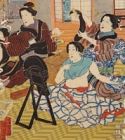Japanese Gallery (Honkan) Room 16
December 23, 2005 (Fri) - January 15, 2006 (Sun)
This display features attractions of Edo that consisted of a wide variety of shows, part of which would be connected to the expositions in the Modern period.
In the later part of the Edo period (1603-1867), shows and attractions served as large form of amusement for the public at large. Many show stands were erected in the areas around Ryogoku and Asakusa. Central among these, the works of craftsmen created a spectacle with elaborate machines that replicated characters from history or ancient tales in order to perform. In Edo (now Tokyo) and Osaka tens of thousands of viewers gathered and the handbills and woodblock prints were used to create a cultural phenomenon that went even adapted for the stage.
Japanese acrobats and jugglers were once praised around the world and held in the highest regard. The acrobat Hayatake Torakichi was so skilled at top tricks that it was banned by the bakufu (military government). Rare animals such as camels, panthers and tigers were brought from overseas in order to wow spectators. It was believed that viewing these rare animals could cure a variety of ills - such as smallpox - exorcisms that were similar to praying in front of deities in degaicho, temple treasure exhibitions that were held outside the temple grounds.
From towards the Ansei era (1854-59), the end of the military government's reign, to the Meiji Period, "living dolls" started to appear. The most popular among them was an image of Mayuzumi, a courtesan at Yoshiwara, who donated a huge sum of 30 ryo to provide food for the sufferers from the great earthquake of the Ansei era which was produced by Matsumoto Kisaburo. Life-sized, very realistically made dolls must have had a considerable impact on the people at the time.

